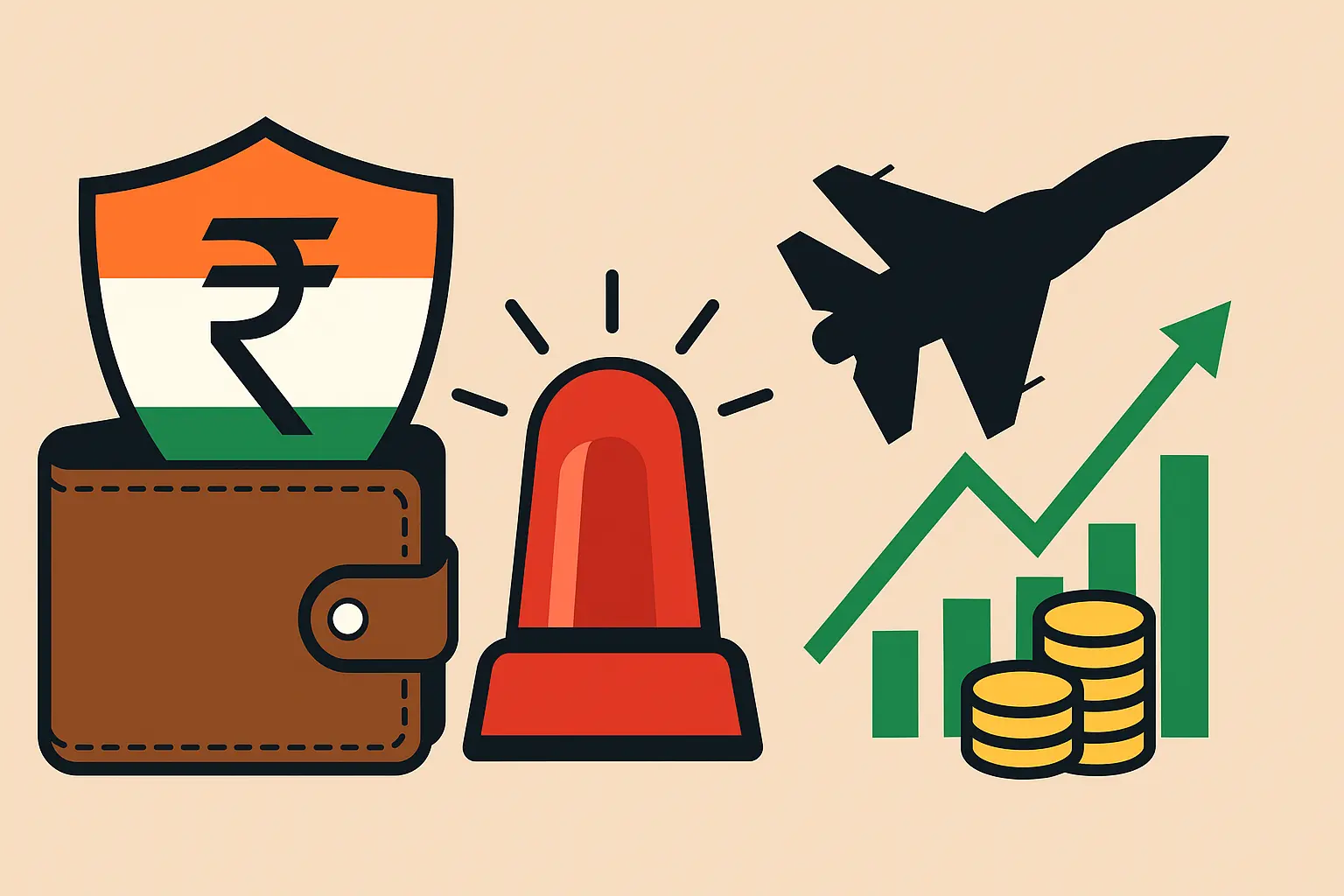
Recent headlines about Operation Sindoor (India’s precision strike on nine terror sites in Pakistan and PoJK on 7 May 2025) and this week’s **nation‑wide civil‑defence mock drill—the first in more than five decades—**are a reminder that national‑security shocks can rattle pocketbooks as easily as borders. Here’s a step‑by‑step plan to keep your money battle‑ready.
1 | Why defence headlines hit your wallet
| Shock channel | What typically happens | Why it matters to you |
|---|---|---|
| Market volatility | Geopolitical scares trigger a flight to safety; the Sensex opened ‑1.9 % on 7 May, while domestic gold jumped ₹650/10 g before noon. | Your equity portfolio can sink before your coffee brews. |
| Supply‑chain friction | Air‑space closures and flight diversions by Air India, Emirates and others raise freight bills. | Costlier APIs and chips can feed inflation in medicines, electronics and more. |
| Fiscal pressure | Higher defence outlays after crises can crowd out social spending or spark new cesses. | Salaries may stagnate while taxes creep up. |
| Sentiment slide | Tourism, auto and real‑estate bookings are the first to freeze. | Jobs, bonuses and variable pay become wobbly. |
2 | Run your own “financial mock drill”
Just as today’s siren tests teach citizens where to duck, a quick personal‑finance drill shows whether your money can withstand a sudden blast of uncertainty.
| Drill question | 5‑minute stress‑test |
|---|---|
| Income disruption: Could you pay three months of EMIs if salary stops? | Maintain an emergency fund ≥ 3× monthly outgo in a sweep FD or liquid fund. |
| Medical shock: Does health insurance exclude war‑like events? | Add a top‑up plan plus personal‑accident rider; read exclusions now, not during a claim. |
| Market crash: How much of your corpus can fall 25 % without derailing goals? | Cap equity to your “sleep quotient”; keep 5–10 % in a gold ETF. |
| Data loss/evacuation: Can you retrieve crucial documents in 5 min? | Store e‑copies in DigiLocker and one waterproof hard copy. |
Run the drill twice a year—every 7 May (mock‑drill day) and 26 July (Kargil Vijay Diwas) are handy reminders.
3 | Build your “war chest” in five steps
Cash buffer, then SIPs
Target: six months of essential spends. Use auto‑sweeps or RBI Retail Direct 91‑day T‑Bills.Destroy high‑interest debt
Credit‑card or personal‑loan rates (24 %+) crush flexibility if layoffs strike. Use the snowball method—kill the smallest balance, then roll payments up.Diversify by correlation, not by count
Ten large‑cap funds aren’t diversification. Pair Indian equities with:
• Gold ETF (often zigs when equities zag in conflicts).
• Global index ETF (NASDAQ 100, S&P 500) for rupee‑hedging.
• Short‑duration gilt fund for quick liquidity.Upgrade cover, downgrade premiums
• Term life: claim‑settlement ratio ≥ 98 %; check war exclusions.
• Health: ₹20 lakh family‑floater + ₹20 lakh super‑top‑up. Review on the IRDAI portal each year.Stock a physical‑needs kit
Two weeks of water‑purification tablets, prescription meds, power bank and small‑denomination notes prevent panic‑buying at peak prices.
4 | Stay informed, not inflamed
Algorithms reward doom‑scrolling; your finances don’t. Adopt a three‑source rule:
Government – PIB press notes, MHA advisories (today’s drill began 16:00 IST across 244 districts).
Mainstream media – BBC, The Hindu, Business Standard for cross‑checked economic angles.
Data feeds – NSE and RBI dashboards for live clues on currency and bond yields.
Set Google Alerts for “Operation Sindoor market impact”, “mock drill today” and “strike on Pakistan gold price” so intelligence lands in your inbox, not just on your timeline.
5 | Action checklist you can finish today
Transfer ₹5,000 to a new liquid‑fund folio—seed your “war chest”.
Upload all policy PDFs to DigiLocker and email yourself a zipped copy.
Start a gold‑ETF SIP (₹2,000/month) in the same app you buy equity funds—set, forget.
Block 30 min this weekend to read your health‑insurance exclusions; add riders if war/terror risks aren’t covered.
Teach one family member—parent, spouse or teenager—how to access emergency money and documents.
Bottom line
National security preparedness and personal finance are two sides of the same rupee coin. When jets scramble and sirens wail, markets, jobs and household cash‑flows can wobble as fast as border lines. Treat every headline—Operation Sindoor, today’s mock drill, tomorrow’s alert—as a cue to rehearse your own readiness. Begin your wallet drill now; the best time to build a bunker is before the first shell lands.

Leave a Reply